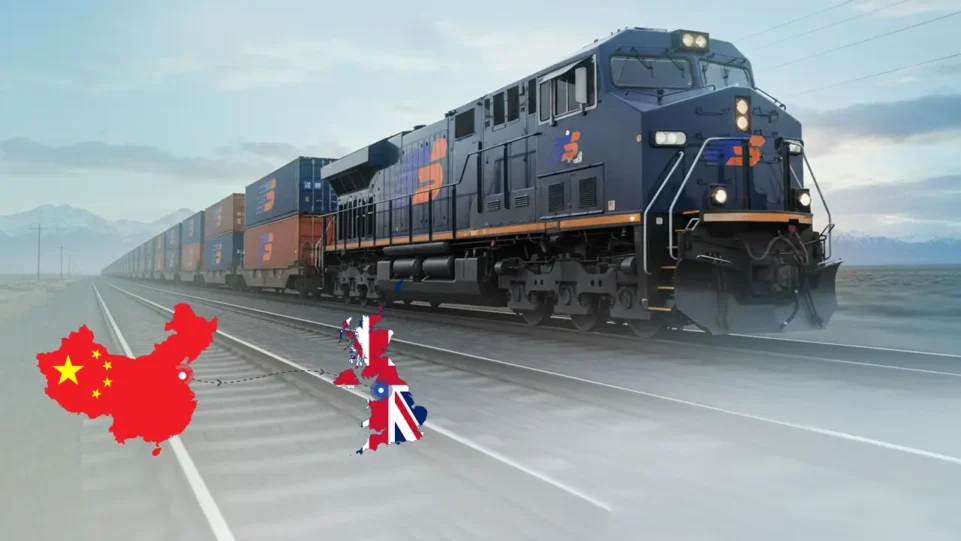As a UK importer, you’re constantly balancing speed and cost. If you’ve been exploring shipping from China to the UK, you’ve probably seen the same two options dominate every discussion, sea and air. But here’s what many businesses still overlook: there’s a third option quietly transforming how goods move between China and Europe.
Rail Freight from China to UK – 2025 Cost & Transit Time Overview
Planning your shipments from China to the UK in 2025? Rail freight offers a reliable balance between cost and speed. Here’s a quick overview of what you can expect in terms of transit times and pricing for different container options.
Cost:
- £80-£150/CBM (LCL)
- £4,500-£6,500 (40ft FCL)
Average Transit Times:
- Average rail freight from China to UK time: 16-28 days door-to-door
- Fastest we’ve seen: 16 days (Yiwu to London)
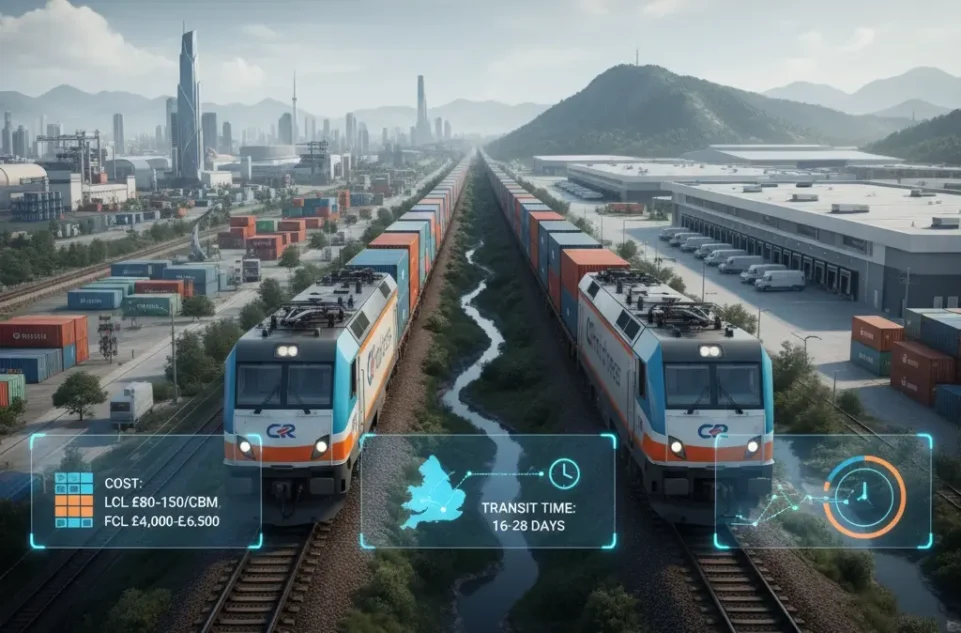
Introduction to Rail Freight from China to UK
Let’s get real for a second. When we talk about the China freight train to Europe and UK, we’re talking about the China Railway Express (CR Express), a massive network of rail routes connecting Chinese manufacturing hubs directly to European distribution centers.
Think of it as the Silk Road reimagined for the 21st century, except instead of camels, we’ve got double-stacked container trains crossing 8,000+ miles of track.
China to UK Rail Freight Services and Shipping Options
Not all train freight is created equal. Understanding which option fits your business can save you thousands while getting your products to market faster. Here’s a complete comparison of all your choices:
| Option Type | Specification | Best For | Cost Range | Transit Time | Key Benefits |
| Container: FCL (40ft) | Full container | 15+ CBM shipments | £4,500-£6,500 | 18-25 days | Best per-unit cost, no delays, exclusive use |
| Container: FCL (20ft) | Full container | 10-15 CBM shipments | £2,700-£4,200 | 18-25 days | Better protection, faster than LCL |
| Container: LCL | Shared space | Under 10 CBM | £80-£150/CBM | 21-28 days | Pay only for space used, flexible |
| Speed: Express | Priority service | Urgent shipments | +15-20% vs standard | 15-18 days | Product launches, time-sensitive |
| Speed: Standard | Regular service | Most shipments | Baseline pricing | 20-25 days | Best cost/speed balance |
| Speed: Economy | Slower service | Low-urgency orders | -10-15% vs standard | 25-30 days | Maximum cost savings |
| Terms: DDP | All-inclusive | Most UK importers | Higher upfront | Same as chosen speed | Hassle-free, no surprises (Recommended) |
| Terms: DDU | Self-clearance | Customs expertise | Lower upfront | Same as chosen speed | You control customs process |
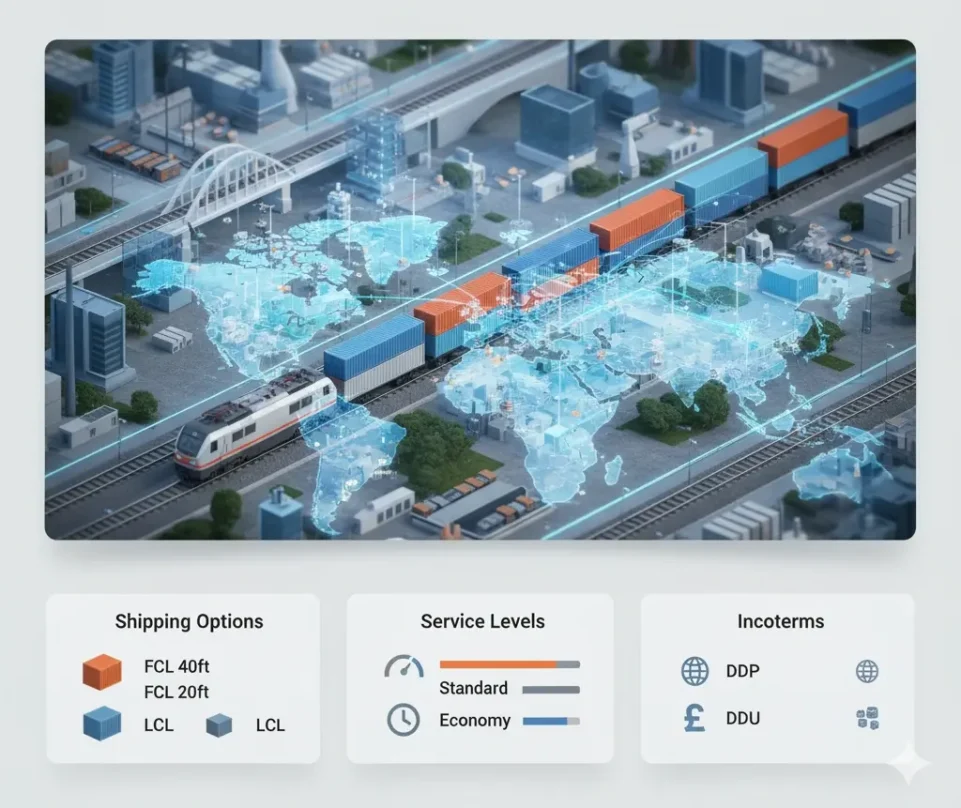
Container Choices:
- Full Container Load (FCL): Book an entire container for exclusive use. The cost of a 40ft container from China via rail offers best value for regular importers, while the cost of a 20ft container from China via rail runs about 60-65% of that price.
- Less than Container Load (LCL): Share container space, paying only for your cubic meters. Perfect for smaller shipments, though transit adds 3-5 days for consolidation.
Delivery Terms (Post-Brexit): For your rail freight from China to the UK, DDP (Delivered Duty Paid) is generally preferred as it handles rail transport, customs clearance, duties, VAT, and delivery, one price, no surprises.
Comparing Shipping Methods: Rail vs. Sea vs. Air (China → UK)
Here’s a conversation we have with importers almost daily: “Which shipping method should I use?” And the honest answer is: it depends on what you’re shipping and why?
| Factor | Rail Freight | Sea Freight | Air Freight |
| Transit Time (Door-to-Door) | 18–25 days | 35–45 days | 5–9 days |
| Cost Level | Moderate (≈50% of air, higher than sea) | Lowest | Highest |
| Best For | Mid-value goods needing balance of speed & cost (textiles, electronics, auto parts) | Low-value or bulky goods (raw materials, furniture) | High-value, urgent, or perishable goods |
| Reliability | High – predictable schedules, fewer port delays | Moderate – port congestion and weather delays common | Very high – strict flight schedules |
When to Choose Rail Freight: The Smart Multi-Modal Approach
Rail makes financial and logistical sense when you are shipping goods valued between $50,000-$500,000 and need a reliable, faster-than-sea solution.
We recommend a mix: Sea freight for base inventory, rail for replenishment orders, and air for emergencies.
Rail Freight Transit Time from China to UK
Let’s talk numbers, because vague promises don’t help you plan inventory. The China to UK train freight time varies based on your origin point and final destination, but here’s what real-world experience shows us.
| Journey Stage | Duration | What’s Happening |
| Factory to Rail Terminal (China) | 1-3 days | Collection, documentation, container loading |
| Rail Transit (China to Europe) | 14-18 days | Actual train journey across Asia/Europe |
| Border Crossings & Inspections | 1-2 days | Kazakhstan, Russia, Belarus/Poland borders |
| European Hub Processing | 1-2 days | Customs clearance, deconsolidation if needed |
| UK Border & Customs | 1-2 days | Post-Brexit customs procedures |
| Final Delivery to Your Warehouse | 1-2 days | Road transport within UK |
| TOTAL DOOR-TO-DOOR | 18-25 days | Complete journey with all handling |
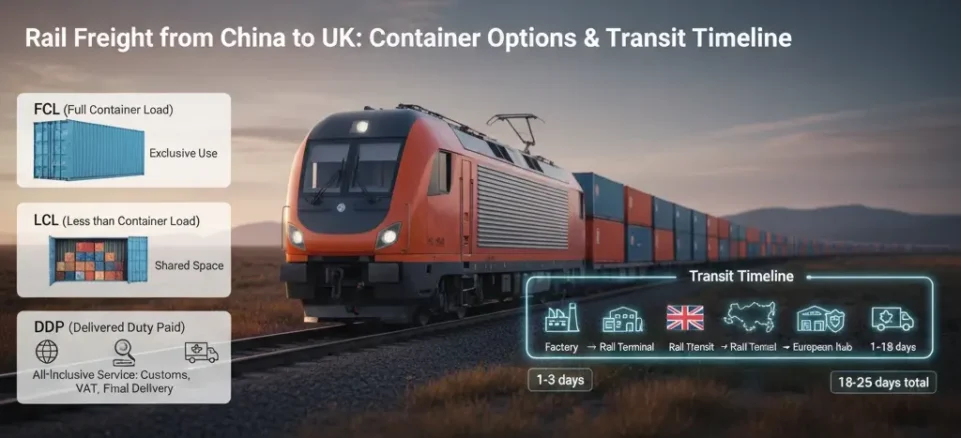
Transit Times by Service Level
Depending on how quickly you need your goods, rail services offer different speed options. Here’s a simple guide to what each service level means for your transit times.
| Service Type | Rail Transit | Total Door-to-Door | Cost Premium | Ideal Use Case |
| Express | 14-16 days | 16-20 days | +15-20% | Product launches, seasonal peaks |
| Standard | 16-18 days | 20-23 days | Baseline | Regular inventory replenishment |
| Economy | 18-20 days | 23-28 days | -10-15% | Low-urgency bulk orders |
Transit Times by Major Chinese Departure Cities
Where your shipment starts in China can affect delivery time. Let’s break down the typical transit durations from key departure cities to the UK.
| Origin City | Rail Transit to Europe | Total to UK | Service Frequency |
| Yiwu | 16-18 days | 20-22 days | Daily departures |
| Chengdu | 16-19 days | 20-23 days | 3-4x weekly |
| Chongqing | 16-19 days | 20-23 days | Daily departures |
| Wuhan | 17-19 days | 21-24 days | 2-3x weekly |
| Xi’an | 17-20 days | 21-25 days | 2-3x weekly |
| Zhengzhou | 16-19 days | 20-23 days | 3-4x weekly |
Yiwu to London Freight Train Time
The Yiwu to London train has become somewhat famous; it’s one of the longest railway routes in the world. The China to Yiwu train time typically runs 18-20 days, and because Yiwu is a major export hub, service frequency is excellent. If you’re sourcing from Yiwu or nearby Zhejiang province, this route offers particularly good value.
What Affects China Freight Train Delivery Time?
China freight train speed averages around 80-120 km/h depending on the route and country. Not bullet-train fast, but consistently steady. And unlike ocean vessels that can get delayed by port congestion (remember the Suez Canal incident?), freight trains from China to UK tend to maintain more predictable schedules.
Factors that can add 1-3 days:
- Seasonal demand peaks (September-November, Chinese New Year)
- Weather conditions affecting border crossings
- Customs inspections (random or triggered by documentation issues)
- Terminal congestion at European hubs

Complete Rail Freight Cost from China to UK
Here’s a clear look at the main costs involved in China freight to the UK, including transport, customs, and delivery, so you know exactly what to expect.
| Cost Component | FCL 40ft | FCL 20ft | LCL (per CBM) | What’s Included |
| Base Rail Transport | £3,200-£4,500 | £2,000-£2,800 | £60-£100 | Train freight from China to European hub |
| European Hub Handling | £300-£500 | £200-£350 | £8-£15 | Terminal fees, deconsolidation (LCL) |
| EU Customs Clearance | £150-£250 | £150-£250 | £80-£120 | Document processing, declarations |
| UK Border Clearance | £200-£350 | £200-£350 | £100-£150 | Post-Brexit customs, VAT processing |
| Final Mile Delivery (UK) | £250-£400 | £200-£350 | £15-£25 | Road transport to your warehouse |
| Documentation & Admin | £100-£150 | £100-£150 | £50-£80 | Bills of lading, certificates, filing |
| Insurance (optional) | £50-£200 | £40-£150 | £10-£30 | 0.3-0.5% of cargo value |
| TOTAL ESTIMATE | £4,500-£6,500 | £2,700-£4,200 | £80-£150/CBM | Complete door-to-door service |
Price Comparison: Rail vs Sea vs Air
Not sure which shipping method makes the most sense for your goods? This comparison highlights cost, speed, and best-use cases for rail, sea, and air freight.
| Shipping Method | 40ft Container | 20ft Container | Per CBM (LCL) | Best Value For |
| Rail Freight | £4,500-£6,500 | £2,700-£4,200 | £80-£150 | Mid-volume, time-sensitive |
| Sea Freight | £2,500-£4,000 | £1,800-£2,800 | £40-£80 | High-volume, flexible timeline |
| Air Freight | £12,000-£18,000 | £8,000-£12,000 | £280-£450 | Urgent, high-value goods |
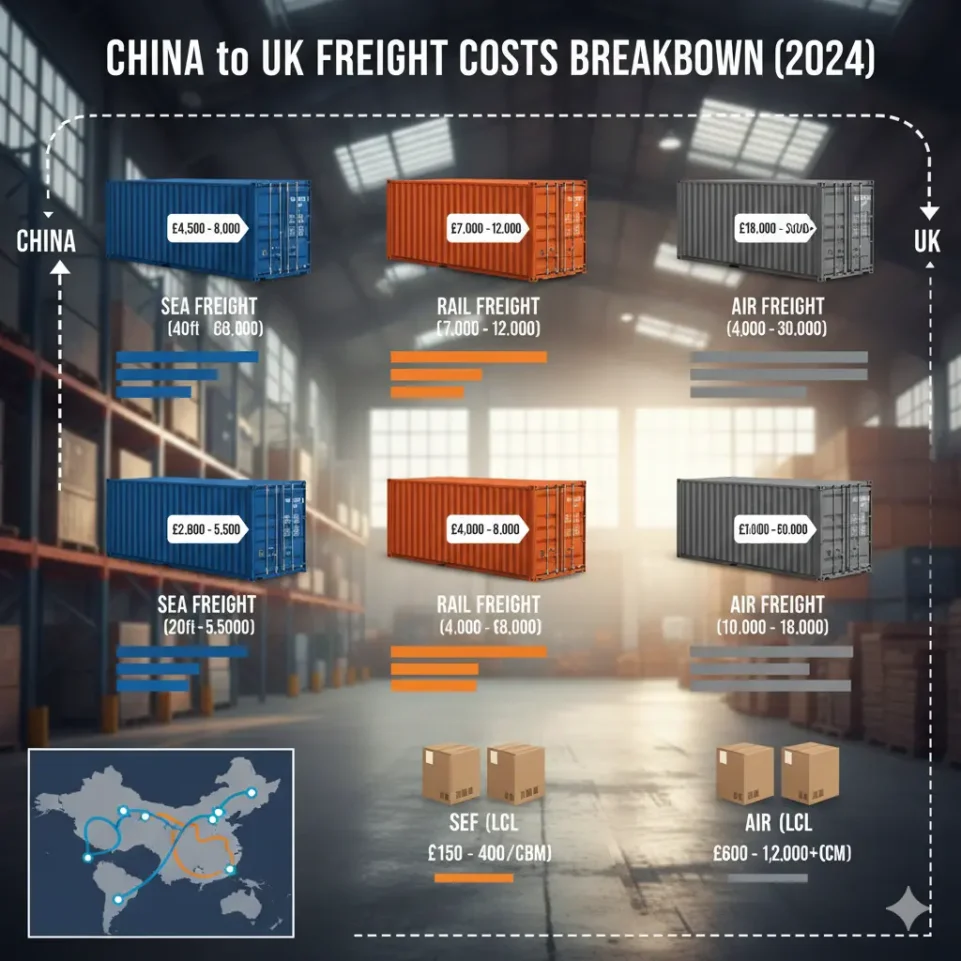
Cost by Service Level
Rail freight offers different service levels depending on how fast you need your shipment. Here’s a quick overview of cost differences and how much time each option can save.
| Service Type | 40ft Container | 20ft Container | Cost Difference | Time Saved |
| Express | £5,200-£7,500 | £3,100-£4,900 | +15-20% | 3-5 days faster |
| Standard | £4,500-£6,500 | £2,700-£4,200 | Baseline | Standard timeline |
| Economy | £3,900-£5,600 | £2,300-£3,600 | -10-15% | 3-5 days slower |
Cost by Major Origin Cities
Where your shipment starts in China affects both price and transit time. This table shows the typical rates from key departure cities to help plan your logistics.
| Departure City | 40ft FCL | 20ft FCL | LCL per CBM | Why Pricing Varies |
| Yiwu | £4,200-£6,000 | £2,500-£3,800 | £75-£140 | Daily service, high volume hub |
| Chengdu | £4,500-£6,500 | £2,700-£4,200 | £80-£150 | Standard rates, good frequency |
| Chongqing | £4,500-£6,500 | £2,700-£4,200 | £80-£150 | Daily departures, competitive |
| Wuhan | £4,700-£6,800 | £2,800-£4,400 | £85-£155 | Less frequent service |
| Xi’an | £4,800-£7,000 | £2,900-£4,500 | £90-£160 | Longer distance to borders |
| Zhengzhou | £4,600-£6,600 | £2,800-£4,300 | £85-£150 | Good connectivity |
The Yiwu to London train cost sits at the lower end because Yiwu is a major departure hub with frequent service. Less common origin points might cost more.
Factors Affecting Freight Train from China to UK Cost
The rail freight from China to UK cost depends on several key factors:
- Cargo Volume & Container Size – Full containers (FCL) cost less per unit than shared space (LCL). The cost of 40ft container from runs 60-70% less than air freight but 20-40% more than sea.
- Route & Destination – Different railway corridors (via Kazakhstan, Poland, or Germany) and your UK destination affect pricing. Major cities may include extra trucking fees.
- Service Speed – Express services (15-18 days) cost 15-20% more than standard rail (18-25 days). Economy options save 10-15% but take longer.
- Customs & Documentation – Clearance fees, inspections, and paperwork processing add to costs. DDP service is pricier upfront but hassle-free.
- Seasonality – Prices spike during peak seasons (Chinese New Year, Christmas) when capacity is tight.
- Additional Services – Warehousing, consolidation, and door-to-door delivery increase costs but add convenience.

Key Factor: Booking Slots and Terminal Congestion: Unlike ocean vessels, rail freight capacity is strictly fixed. During peak seasons (such as post-CNY or pre-Christmas), securing your space on the train (the ‘slot’) can be challenging. Partnering with a provider like TopShipping, which holds secured Block Train Agreements at key terminals, ensures your cargo moves without waiting for available space.
Hidden Costs to Watch For
Most freight forwarders don’t include everything in initial quotes. Always ask about:
- Customs clearance fees (EU and UK)
- Terminal handling charges
- Final mile delivery costs
- Insurance (essential)
- Documentation fees
At TopShipping, we provide all-inclusive pricing upfront; No surprise charges when your goods arrive.
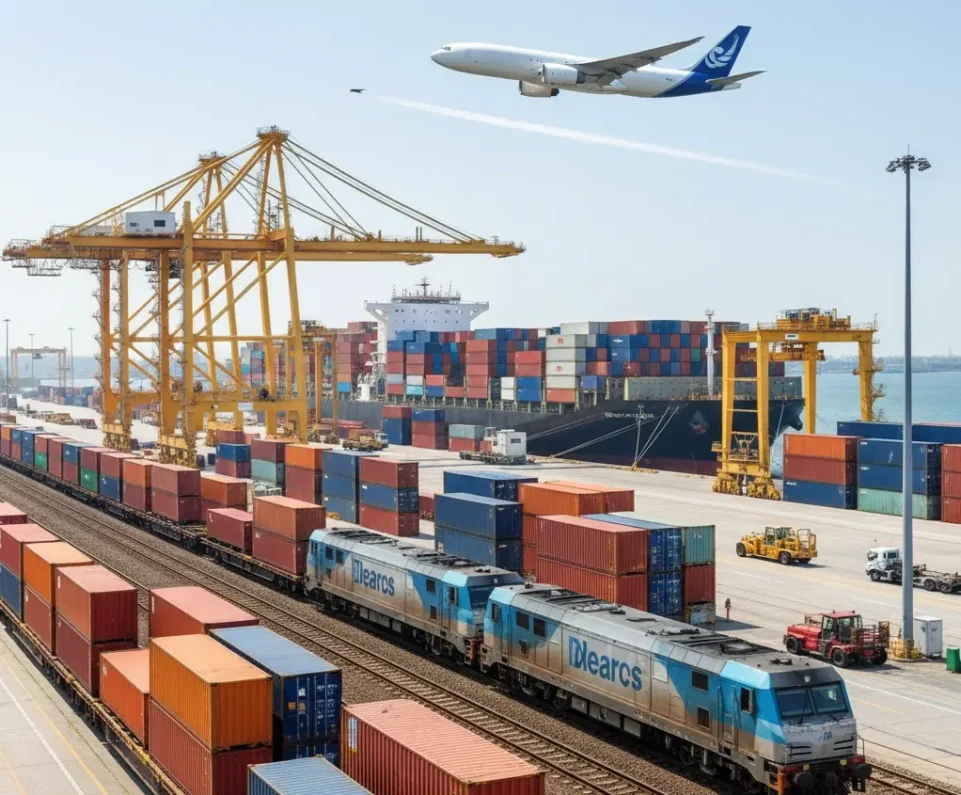
Incoterms Impact on Delivery Time and Cost (China–UK Rail Freight)
Transit times can also vary slightly depending on your chosen Incoterm. For example, under DDP (Delivered Duty Paid) or DAP (Delivered at Place), the forwarder handles the full journey including customs and final-mile delivery in the UK, which may add 1–2 days to the total lead time. If you’re using FCA or CPT, the responsibility transfers earlier, so your UK-side logistics need to be ready in advance. If you’d like to understand these trade terms in more detail, including what each one means for your shipping costs and responsibilities. check our complete guide to Incoterms.
| Incoterm | Description | Recommended for Rail Freight? | Key Consideration |
| EXW (Ex Works) | The buyer covers all costs from the factory gate in China to the final destination. | Common in China trade | Requires full logistics coordination by the buyer, including rail booking. |
| FCA (Free Carrier) | The seller delivers goods to the carrier (e.g., the rail terminal in China). | Very common for rail freight | Responsibility and cost transfer to the buyer at this point. |
| CPT (Carriage Paid To) | The seller pays for transport to a named destination in Europe or the UK. | Suitable for rail freight | Ideal for importers who prefer all-in freight rates. |
| CIP (Carriage and Insurance Paid To) | Similar to CPT, but includes transport insurance. | Good for high-value cargo | Recommended for electronics, precision parts, or sensitive goods. |
| DAP (Delivered At Place) | The seller handles delivery up to the agreed destination in the UK. | Very popular | Often offered by experienced freight forwarders for convenience. |
| DDP (Delivered Duty Paid) | The seller manages everything, shipping, customs, and taxes. | Occasionally used | Easiest for the buyer, but usually more expensive; suitable when the seller has export expertise. |
Rail Freight Route from China to UK: Key Hubs and Path Overview
Here’s where it gets interesting. Unlike sea freight where you’ve basically got one option (sail around half the world), China freight rail offers multiple route possibilities.
Main Rail Corridors for China to Europe Freight
- The Trans-Siberian Route: This cuts through Russia and is typically the fastest option for freight train from China to Europe. Your containers depart from hubs like Chongqing or Wuhan, cross into Kazakhstan, traverse Russia, and enter the EU through Belarus or Poland. Total distance? About 11,000 kilometers.
- The Central Corridor: Routes through Kazakhstan and the Caspian Sea region, offering an alternative that avoids some geopolitical sensitivities. It’s slightly longer but provides valuable route diversity.
- The Southern Route: Winds through Kazakhstan, Uzbekistan, and Iran before reaching Turkey and Europe. This one’s less common for UK-bound freight but worth knowing about.
Route Options at a Glance
Your China to UK freight train can complete its journey via:
- Rail to European Hub + Road Delivery: Most cost-efficient, containers reach Duisburg, Warsaw, or our Luxembourg hub, then truck to UK
- Rail + Short-Sea Shipping: Through Rotterdam or Antwerp ports, sometimes faster for coastal UK destinations
- Flexible Routing: TopShipping adjusts routes based on real-time conditions, no micromanagement needed
Understanding the China to UK Train Route Map
For most shipments, your goods will arrive at major European rail terminals; Duisburg in Germany is massive, as is Małaszewicze in Poland. But here’s where TopShipping’s Luxembourg advantage kicks in (more on that in a minute).
The actual freight train route isn’t a straight shot to London, obviously. The train route typically looks like this:
- Chinese departure city (Yiwu, Chengdu, Chongqing, Wuhan)
- Overland rail through Kazakhstan and Russia
- EU border entry (Poland or Belarus)
- European terminal arrival (Germany, Poland, or Luxembourg)
- Customs clearance and transshipment
- Final delivery to UK destination via road or short-sea shipping
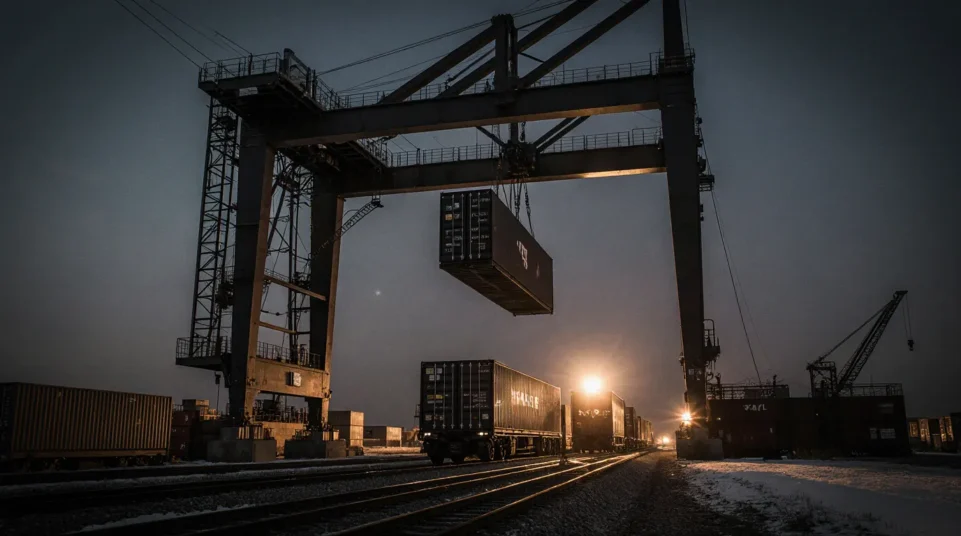
Note: At the border between China/Kazakhstan and subsequently the Belarus/Poland border, containers must be moved from standard-gauge railcars onto the broader Russian-gauge railcars, and vice versa. This complex operation (requiring specialized equipment) typically takes only 12 to 24 hours and is one of the logistical marvels of this route, offering much more predictability than typical port delays.
Documentation and Customs for Rail Freight from China to UK
Let’s be honest, this is where many rail freight shipments go sideways. The freight train from China to London might run perfectly, but if your paperwork isn’t spot-on, you’re looking at delays, fines, or even cargo holds.
Essential Documents for China Freight Railway to UK
For China freight railway shipments to UK, you absolutely need:
- Commercial invoice (detailed, accurate values, seriously, don’t fudge this)
- Packing list (down to individual carton level)
- Bill of Lading (rail version, called a Consignment Note)
- Certificate of Origin (especially important for tariff calculations)
- Product-specific certificates (safety, compliance, etc. depending on what you’re importing)
UK-Specific Post-Brexit Requirements
- VAT registration and EORI number are non-negotiable now. The days of simplified EU procedures are gone. Every shipment needs proper customs declarations at UK border points.
- Commodity codes (HS codes) need to be accurate. An incorrect code might mean paying wrong tariff rates, and HMRC will eventually catch it, usually at the worst possible time.
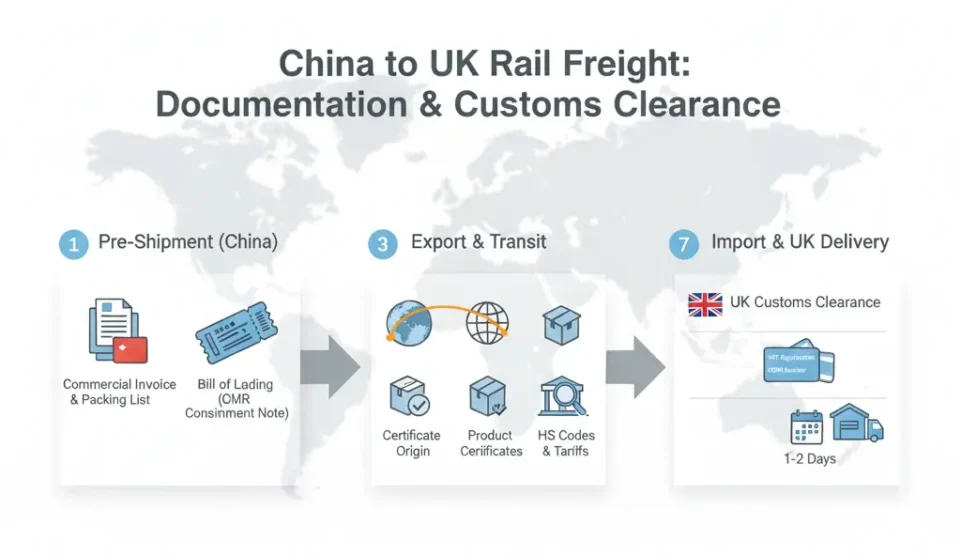
How TopShipping Prevents Documentation Disasters
Here’s what we do differently at TopShipping: we review your documentation before your cargo leaves China. Not when it’s sitting at a European terminal. Our team catches common mistakes (wrong HS codes, missing certificates, valuation issues) while there’s still time to fix them without delaying your shipment.
Because here’s the thing; Other freight forwarders might get you a great rate on the actual rail transport, but then charge you premium “rush” fees to fix documentation emergencies they should have prevented. We’d rather do it right from the start.
Finding The Best Rail Freight Service (China-UK)
So, is rail freight from China to UK right for your importing needs? Here’s our honest assessment framework:
Rail Makes Perfect Sense If You’re Importing:
- Regular shipments (monthly or more frequent)
- Products worth $50K-$500K per shipment
- Goods where 2-3 weeks faster delivery than sea freight creates value
- Items that don’t justify air freight’s premium cost
You Might Want to Reconsider If:
- You ship once or twice a year (sea freight’s savings might outweigh convenience)
- Your products are extremely heavy and low-value (sea freight wins on economics)
- You genuinely need goods in 5-7 days (air is your only option)

The Critical Difference: TopShipping’s Track Record
Choosing the right partner is crucial. Rail freight only works if you’re working with a freight forwarder who truly understands this shipping method, has the European infrastructure to make it seamless, and treats your shipments like they matter.
TopShipping’s team has been running China to UK freight train routes since this service reached commercial maturity. We’ve navigated route disruptions, customs regulation changes, Brexit complications basically every curveball this shipping method can throw. That experience translates to your shipments arriving on time, every time.
FAQ: Rail Freight from China to UK
Is There a Freight Train from the UK to China?
Yes, rail freight UK to China is absolutely possible for UK exporters.
What’s the minimum shipment size for rail freight?
Technically 1 CBM via LCL, but rail makes most economic sense from about 5 CBM upward.
Can I ship dangerous goods via rail?
Depends on the classification; tell us what you’re shipping upfront as rules are strict.
What happens if there’s a delay?
Delays are rare (typically 2-3 days), but we notify you immediately with updated estimates.
How long does rail freight from China to the UK actually take?
The average total transit time is usually 18 to 25 days door-to-door. The express service level can often bring this down to around 16–20 days. This is roughly half the time of sea freight and offers the reliability that ocean vessels often lack.
Does the same train run all the way from China to the UK?
No. The container travels via the China Railway Express across Eurasia, but it requires two key transfers:
- Gauge Change: At the China/Kazakhstan border and the Belarus/Poland border, the containers are quickly transferred to different rail units because the track width (gauge) changes.
- Final Leg: After arriving at a key European rail terminal (like Germany or our Luxembourg hub), the container is transferred to a shuttle train or truck for the final, fast journey across the Channel to the UK.
Is there a freight train service from the UK back to China?
Yes, absolutely. The China-Europe rail route is a two-way service. UK exporters use it to ship high-value goods, machinery, and automotive components to China and other Asian markets.
How does the cost compare to sea and air freight? Rail freight cost sits in the middle:
It is typically 20–40% higher than standard ocean freight. It is usually 60–70% lower than air freight. It’s the most cost-effective choice when reliability and speed (faster than 35+ days) are necessary, but air freight’s premium is too high.
What is the minimum volume for rail freight?
Technically, you can ship small volumes via LCL (Less than Container Load) rail freight (starting around 1 CBM). However, rail becomes most economically advantageous for shipments above 5 CBM and up to a full container (FCL).
Can I ship high-value or hazardous goods via rail?
Rail is excellent for mid-to-high value goods (like electronics or fashion) where the cost of delay is high. For hazardous goods (HAZMAT), certain classifications are permitted, but regulations are stricter than sea freight. We must check the specific HS codes of your products upfront to confirm eligibility.
Where does customs clearance happen for UK-bound rail freight?
Due to the post-Brexit landscape, clearance involves several steps:
- EU Entry: Your container is declared for transit (under a T1 bond) upon entering the EU, often in Poland or Germany.
- UK Import: Final import clearance, including the payment of duties and VAT, is completed once the container arrives at the UK terminal or warehouse. Our DDP service handles all of this seamlessly for you.
What essential documents are needed for the China freight railway?
You must provide accurate and compliant documents to avoid border delays:
- Commercial Invoice and Packing List (highly detailed).
- Rail Waybill (the rail equivalent of a Bill of Lading).
- Certificate of Origin (COO).
- A valid UK EORI number.
Do I need to get separate insurance for rail freight?
Yes. Standard Marine Insurance policies usually do not cover the overland rail journey. It is absolutely essential to arrange specific, competitive Cargo Insurance for rail freight, covering the full door-to-door route. We can arrange this for you at a low rate (typically 0.3%–0.5% of cargo value).
